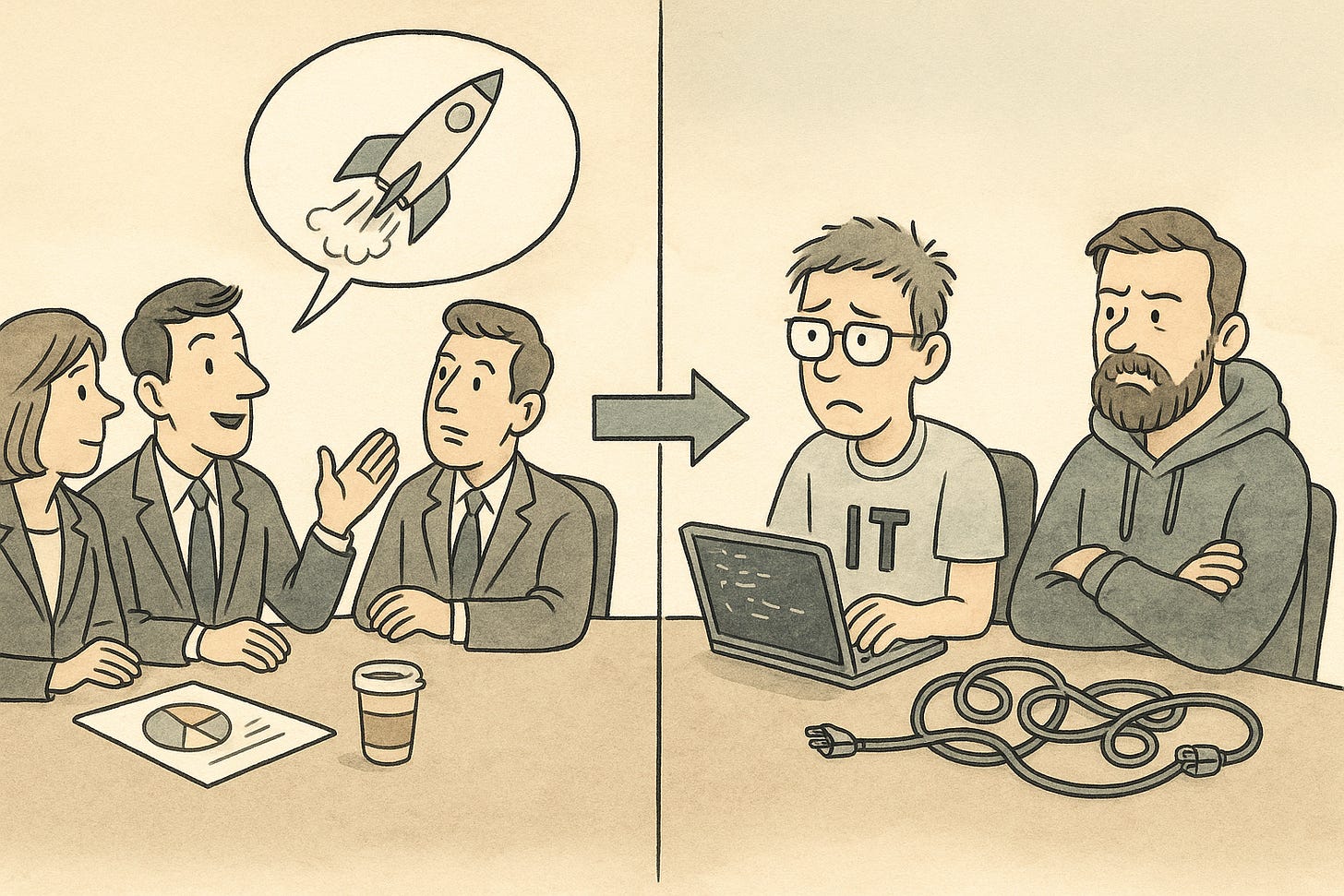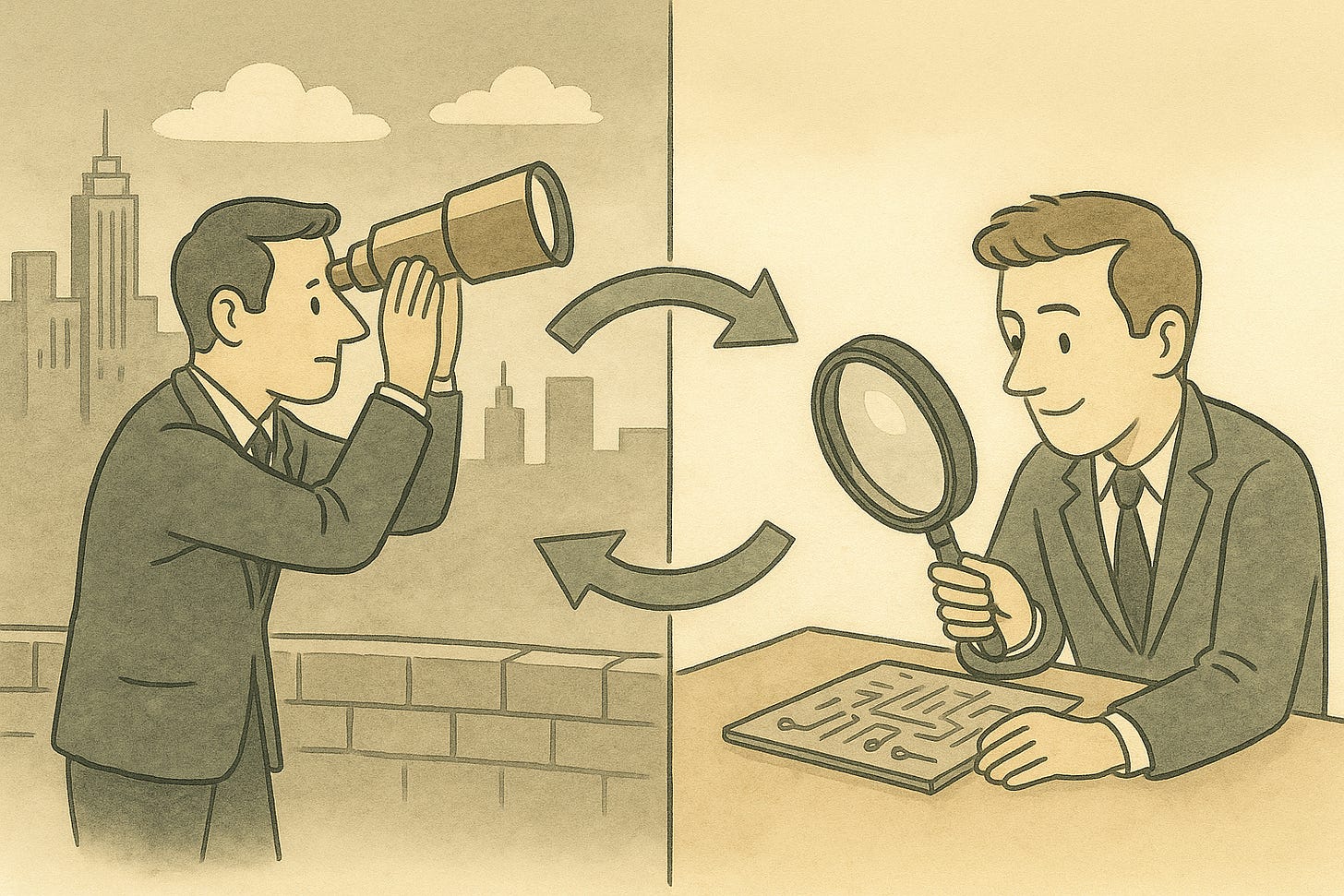When Smart People Hit Stubborn Problems: The AI Framework That Changes Everything
When traditional thinking fails, this 10-minute prompt cuts through the fog and reveals a better path
The meeting is dead in the water. Again.
You're watching two brilliant teams talk past each other for the third time this week. The Product Marketing Manager paints the big picture: "strategic co-pilots," and "proactive intelligence," transforming entire workflows. They see the market, the competition, the user's career trajectory.
The Lead Engineer dissects the technical aspects: API latency, data throughput, prediction model accuracy. They see the endpoint, the code, the infrastructure that actually has to work.
Both teams are smart and committed, and yet they're getting absolutely nowhere.
The feature sits stalled, the roadmap stays blocked, and every meeting ends in polite, mutual incomprehension. No one is disagreeing; rather, they're operating at completely different altitudes. One team flies at 30,000 feet while the other works at 3 inches.
This is where ambitious professionals get trapped. We dig deeper into our default view, convinced that more focus will crack the problem. Marketing leaders zoom out further. Engineers zoom in tighter. Both approaches fail.
Real breakthroughs don't come from staring harder at the problem. They come from deliberately shifting your perspective. The solution isn't "in the weeds" or "in the clouds"; it's actually in the systematic movement between both views.
The Strategic Edge: Why Most Problem-Solving Fails
What separates strategic thinkers from everyone else is their refusal to get stuck at one cognitive altitude.
While others pick a lane and stay there, strategic operators move fluidly between the big picture and the tactical details. They zoom out to see the entire board, then zoom in to spot the winning move. We call this the Full-Spectrum StrAItegy, and it's your systematic approach to cutting through any deadlock.
This isn't about working harder. It's about thinking clearly, and AI is the perfect thinking partner to help execute this framework.
The challenge? Forcing yourself to change perspectives is difficult. Our brains get locked into departmental thinking. Marketing sees strategy; engineering sees execution. Personal incentives reinforce these silos.
AI breaks this pattern. An LLM has no turf to protect, no ego invested in particular solutions. It can adopt a strategic view one moment and tactical focus the next, without bias or politics. This makes it your ideal partner for running a structured thinking process that breaks deadlocks.
Here's exactly how strategic leaders are using AI to solve what everyone else can't.
The Framework: Step-Back Prompting Meets Predictive Forecasting
This approach combines two advanced prompting techniques that transform AI from task-executor into strategic partner.
The "Zoom Out" (Step-Back Prompting): Instead of diving into your specific problem, you force the AI to identify underlying principles, industry forces, and strategic context. Think film director pulling back from close-up to landscape shot. This activates abstract reasoning and reveals strategic patterns invisible when you're too close to the action.
The "Zoom In" (Predictive Forecasting): Rather than static problem-solving, you prompt the AI to project 2-3 possible futures. This moves you from reactive thinking to strategic scenario planning, just like storyboarding the next few scenes to see where the plot leads. It forces consideration of second-order effects and long-term consequences.
The result? Your next move isn't just a reaction; it's a deliberate step toward competitive advantage.
Your Strategic Playbook: Copy, Paste, Win
Here's the prompt framework, ready for immediate deployment. Use this when you're stuck and need to break through to strategic clarity.
Before You Start: Fill out the "My Problem" section at the bottom with your specific situation, industry context, and desired outcome.
For AI, context is king. Vague problems lead to vague answers, so provide as many details as you can: Name the teams, the product/feature, and the exact point of friction. The more context you provide, the more targeted, relevant, and effective the AI's guidance will be!
🚀 The Prompt:
# Persona
You are a Senior Strategic Advisor. Your expertise lies in cutting through complexity to provide clear, actionable frameworks for decision-making. You will guide me through the "Full-Spectrum StrAItegy" to unblock a problem I am facing.
# The StrAItegy: Full-Spectrum Analysis
I will provide you with a problem or blocker. You will guide me through the following three phases, asking me for input where necessary and pausing for my response before proceeding to the next phase.
**Phase 1: Zoom Out (The Wide Shot - Step-Back Analysis)**
Based on my problem statement, your first step is to analyze the broader context. Generate 3-5 powerful, abstract questions that force a "zoom out" from the immediate issue. These questions should probe the underlying principles, hidden assumptions, and external forces that might be at play.
Examples of question types:
- "What are the fundamental principles of [relevant field] that apply here?"
- "What larger trends in [user's industry] might be shaping this situation?"
- "If we re-framed this problem as an opportunity, what would it be an opportunity for?"
Present these questions to me and wait for my reflections.
**Phase 2: Zoom In (The Final Scenes - Predictive Forecasting)**
Based on my reflections from Phase 1, your second step is to project potential futures. Generate 2-3 distinct and plausible scenarios of what might happen in the next 6-12 months if this problem is (or isn't) solved. For each scenario, describe:
- The likely outcome.
- The key contributing factors.
- A potential "headline" that would describe this future state.
Present these scenarios to me.
**Phase 3: Synthesize (The Director's Cut - Actionable Path)**
Based on the insights from the "Zoom Out" and "Zoom In" phases, your final step is to synthesize this full-spectrum view into a clear path forward. Provide 2-3 immediate, pragmatic, and actionable next steps I should take to address my original problem. Each step should be grounded in the context we've built.
---
# My Problem
**My Problem/Blocker:** [Clearly state the problem you are stuck on. Be specific. e.g., "My engineering and marketing teams are constantly misaligned on the go-to-market strategy for our new feature, causing launch delays."]
**My Industry/Context:** [Provide brief context. e.g., "We are a B2B SaaS company in the competitive cybersecurity space."]
**My Desired Outcome:** [What would success look like? e.g., "A streamlined go-to-market process where both teams are aligned and we can launch features on time."]
The Framework in Action: Breaking Through Real Deadlocks
Let's return to our stalled SaaS feature. Here's what strategic problem-solving actually looks like when you run it through the Full-Spectrum framework:
Phase 1: Zoom Out (Strategic Questions Generated)
What fundamental shift in our user's workflow does this "strategic co-pilot" actually create?
What is the core promise we're making to users with this feature, and how does our engineering philosophy [speed, accuracy, reliability] deliver that promise?
If we reframed this misalignment not as conflict, but as productive tension between "market narrative" and "product reality," where's the most powerful intersection?
Phase 2: Zoom In (Future Scenario)
Headline: "B2B SaaS Disruptor Redefines Analytics Category with Launch of 'Proactive Intelligence' Co-Pilot"
Outcome: The feature launch becomes a breakout success, praised for cohesive user experience that delivers on "thinking ahead" for users. Competitors scramble to catch up, still competing on dashboards while your company owns the "proactive intelligence" narrative.
Contributing Factors: PMM and Lead Engineer aligned on single "Strategic Operator" persona. API technical specs prioritized delivering proactive alerts. Launch campaign told that specific story, avoiding generic AI talking points.
Phase 3: Synthesize (Your Strategic Path)
Mandate Joint Definition: Task PMM and Lead Engineer to co-author one-page "Promise & Proof" brief. Must map top 3 "proactive intelligence" promises from marketing directly to top 3 technical functions that prove them.
Launch 1-Week Use-Case Sprint: Run rapid sprint storyboarding five critical alerts the "Strategic Operator" receives from the feature. Each storyboard requires joint sign-off from both teams.
Establish Shared Metric: Implement one cross-team metric for launch success: "Weekly active usage of proactive alert feature by Strategic Operator cohort."
Notice the structured approach. This is core StrAItegy methodology: by guiding AI through systematic reasoning (Abstract → Predict → Act), you get strategic insights instead of surface-level suggestions.
Scaling Your Strategic Advantage: Framework Across Career Levels
This framework scales with your ambitions and responsibilities:
Individual Contributors: Focus on project blockers. Use it to find new angles on stalled tasks or gain clarity on your piece of larger initiatives.
Managers and Team Leads: Apply to cross-functional challenges. Diagnose process friction, resolve team misalignment, or pressure-test new workflows.
Directors and Executives: Deploy for strategic dilemmas. Evaluate market-entry risks, assess competitive threats, or reframe entire business unit approaches.
Three Traps to Avoid
Getting Stuck in the Clouds: The "Zoom Out" phase is for perspective, not a permanent vacation from the details. Use the high-level view to identify leverage points, then commit to coming back down to act on them.
Getting Stuck in the Scenarios: The "Zoom In" phase is for foresight, not fortune-telling. Don't chase every possible future. Choose the most plausible 2-3 scenarios to clarify the stakes, then move to action.
Outsourcing Your Judgment: The AI is your strategic partner, not your boss. Use its output to challenge your assumptions and reveal blind spots, but you still own the final decision.
The Professional Transformation: From Operator to Strategic Leader
You now have a systematic approach to getting unstuck.
The feeling of being trapped in a problem is a signal; not that you need to try harder, but that you need to shift perspective. By systematically zooming out then zooming in, you're not just solving immediate problems. You're building the strategic muscle that separates operators from leaders.
This is how you move from executing tasks to directing outcomes. From being constrained by immediate challenges to seeing the full spectrum of strategic possibilities.
While others stay trapped in their default altitude, you move fluidly between strategic vision and tactical execution. This flexibility becomes your competitive edge, making you indispensable when complex problems need solving.
You have the playbook. Your next challenge is waiting.
Take that issue sitting on your desk, run it through this framework, and see the board differently.
What kind of insights surfaced for you? Let us know in the comments.
Ready for More AI Strategy Insights? Let's Keep You Ahead of the Curve.
We at StrAItegy Hub are working towards building tools and frameworks that turn AI complexity into competitive advantage. If you're serious about staying ahead in the AI-enabled workplace, we've got more for you.





